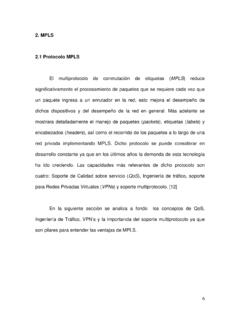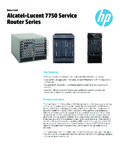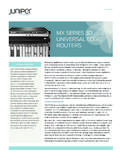Transcription of Seamless MPLS - En Pointe Technologies
1 WHITE PAPERC opyright 2010, Juniper Networks, Inc. 1 Seamless MPLS2 Copyright 2010, Juniper Networks, PAPER - Seamless MPLST able of ContentsAbstract ..3 Introduction ..3 mpls in the Access ..3 Benefits..3 Scaling ..4 Effectiveness ..4 Thus Far, but No Further ..4 Seamless mpls ..4 Decoupling ..4 Network Architecture ..5 Components ..5 Connectivity Blueprint ..5 Transport Pseudowires ..6 Scaling ..6 Control Plane ..7 Putting It All Together ..7 Service Restoration ..8 OAM: Failure Detection and Isolation ..8 Service Architecture ..9 Rigid Service Edge ..9 Flexible Service Delivery ..9 New Service Rollout ..9 Conclusion ..10 References ..10 About Juniper Networks ..11 Table of FiguresFigure 1: Connectivity Blueprint, from the most basic (bottom) to the most detailed (top).
2 5 Figure 2: Components, Transport Pseudowires and Regions.. 6 Figure 3: Intra- and Inter-Region LSPs; BGP-based Hierarchy ..8 Copyright 2010, Juniper Networks, Inc. 3 WHITE PAPER - Seamless MPLSA bstractJust when you thought that mpls has peaked, that the pace of innovation has slowed, and that mpls is getting boring, two promising new developments namely mpls in the access and Seamless mpls bring fresh excitement to service provider networks. mpls in the access is evolutionary, but a necessary prerequisite to Seamless mpls , which has the potential to revolutionize the life cycle of service is hard to overstate the impact that mpls has had on service provider networks. In half a decade (1999 2004), mpls transformed the WAN portion of most service providers.
3 mpls s fast-paced deployment can be attributed to two key qualities: its excellent synergy with IP (an almost universally deployed technology) and its versatility. This versatility was evidenced by the wide variety of reasons that mpls was introduced into networks: for traffic engineering and enhanced quality-of-service (QoS) features; for fast restoration on network failures; for convergence of multiple networks to a single infrastructure; and for a new service, BGP/ mpls IP VPNs, which serves both as a technology for service provider-based VPNs for enterprise clients and as a technique for compartmentalization of network elements (see RFC3209, RFC4090, RFC4364, and mpls Apps).Over the past half decade, mpls has made inroads both to the rest of the service provider world as well as to other parts of service provider networks, such as the metro area network (MAN) and access networks.
4 The timing is fortuitous, supporting another sweeping change: the migration of TDM-based infrastructure to Ethernet. Ethernet, while an extremely successful LAN technology, needed help to meet the stringent requirements of service provider networks mpls filled in nicely. mpls has also progressed functionally, with the emulation of point-to-point and multipoint-to-multipoint Layer 2 services (RFC4447, RFC4761, and RFC4762), and the addition of multicast capabilities, both natively in mpls (RFC4875) and within VPNs (mVPN). These developments are of interest from two points of view: (a) a carrier-grade infrastructure for the metro network, and (b) a vehicle for offering new expansion outward from the core, however, has been opportunistic and somewhat haphazard.
5 mpls in the access asks the question: Why shouldn t mpls be used in all access networks in a systematic fashion? This has several benefits and several challenges. Juniper considers the benefits significant and the challenges solvable. The following sections contain a high-level architecture for mpls in the access. Seamless mpls takes this one step further to an analysis that asks what fundamental change would occur if the entire network were based on mpls . The result is startling, and offers a new view of mpls not just as a network technology, not as a service in itself, or as a service enabler but also as a vehicle for flexible service delivery. This last aspect has the potential to dramatically change the nature of service in the AccessAs stated previously, mpls has proven its value in the WAN, so much so that most WANs are built around mpls .
6 At the same time, MANs are changing from TDM- and ATM-based networks to ones based on Ethernet. The first question that arises with such a change is what should the underlying infrastructure for an Ethernet-based metro and access network be? The success of mpls in the WAN naturally suggests the use of mpls here as well. This leads to the next set of questions. Will the benefits seen in the WAN play out in the metro and access as well? Will mpls scale to the required extent? Can mpls fill this role effectively? What leads to Seamless mpls ? What else will make this possible? We ll take these questions in idea of using mpls for access is not new. It is already being done for some applications such as mobile or DSL backhaul. The benefits of mpls seen in the WAN are apparent in these applications as well.
7 Thus, the question of how mpls will improve metro and access networks is clear. Some standards organizations (such as the IP/ mpls Forum and the Broadband Forum) are attempting to formalize these approaches. However, these deployments are somewhat ad hoc. What is being suggested in this paper is the systematic use of mpls for the entire access and metro network whether mobile or fixed, residential or business, copper or fiber. Several service providers are looking at the implications of doing Copyright 2010, Juniper Networks, PAPER - Seamless MPLSS calingWhile the question of the benefits of using mpls in metro and access networks has been answered, the issue of scalability is harder. WANs generally consist of on the order of 100 to 1,000 Layer 3 devices.
8 A metro network consists of about the same number of devices, albeit both Layer 2 and Layer 3. However, an entire network may contain several dozen metros. Enabling mpls across this network means having 10 to 100,000 mpls nodes, a degree of scale not yet seen in today s mpls networks. Fortunately, we know we can build very large networks, in particular, the public IP network, which consists of several million devices. We will employ many of the same techniques used to build these IP networks to demonstrate an architecture for large mpls third question, regarding mpls s effectiveness in the metro and access, will be determined by three factors. The first is whether an mpls -based metro can be cost-effective. Economies of scale, tighter integration of mpls and transport, and mpls s maturity all indicate that this is possible, even inevitable.
9 The second is whether such a network is manageable. Recent efforts that focus on this issue, such as mpls plug-and-play and improved OAM capabilities, signal a move in the right direction. The final factor is the value of operational convergence, the advantage of a single forwarding paradigm across the whole network. While this may seem obvious from a technical point of view, realizing this advantage may require a structural change in the organization of the service provider. Thus Far, but No Further Now, consider an ATM-based access network. DSLAMs connect to BRASs via ATM circuits. ATM virtual circuits are offered to enterprise customers as an on-ramp to the Internet or a corporate VPN. ATM even provides the technology for mobile (3G) backhaul.
10 Thus, there is a single converged access technology. Unfortunately, this does not extend into the WAN, nor provide most of the services. The border between the ATM access network and the IP WAN network is stiff, even rigid moving it requires redeploying physical devices, maybe even re-architecting the network, and reassigning responsibilities. The real drawback, however, is that this border defines where the majority of services are delivered. This lack of flexibility seriously hampers service providers business. This is true whether the boundary is defined by a technology (ATM versus IP), geography (metro versus WAN), administration (mine versus yours), or other means. The advent of Ethernet-based metros and access networks does not in itself change MPLSThis constraint on service delivery brings us to the fourth question.








